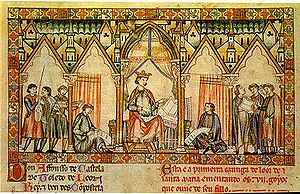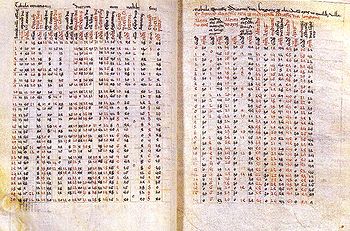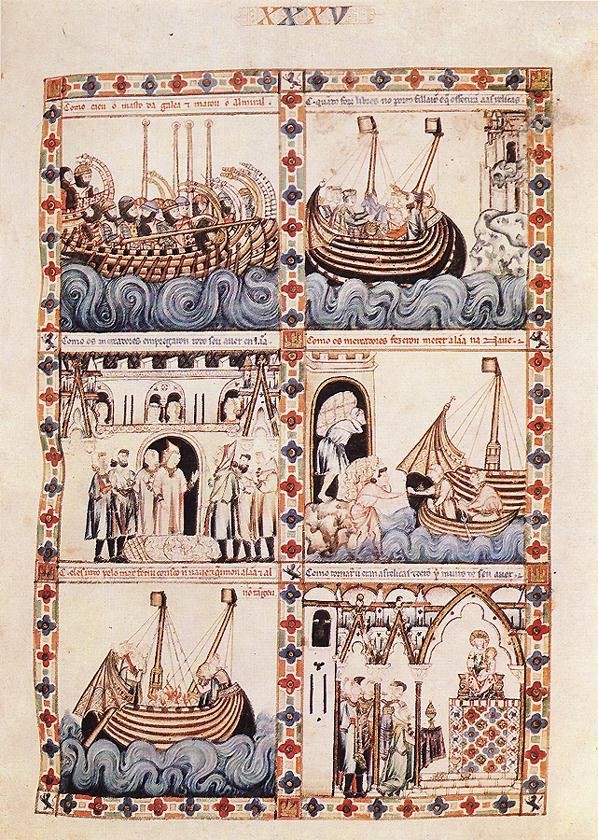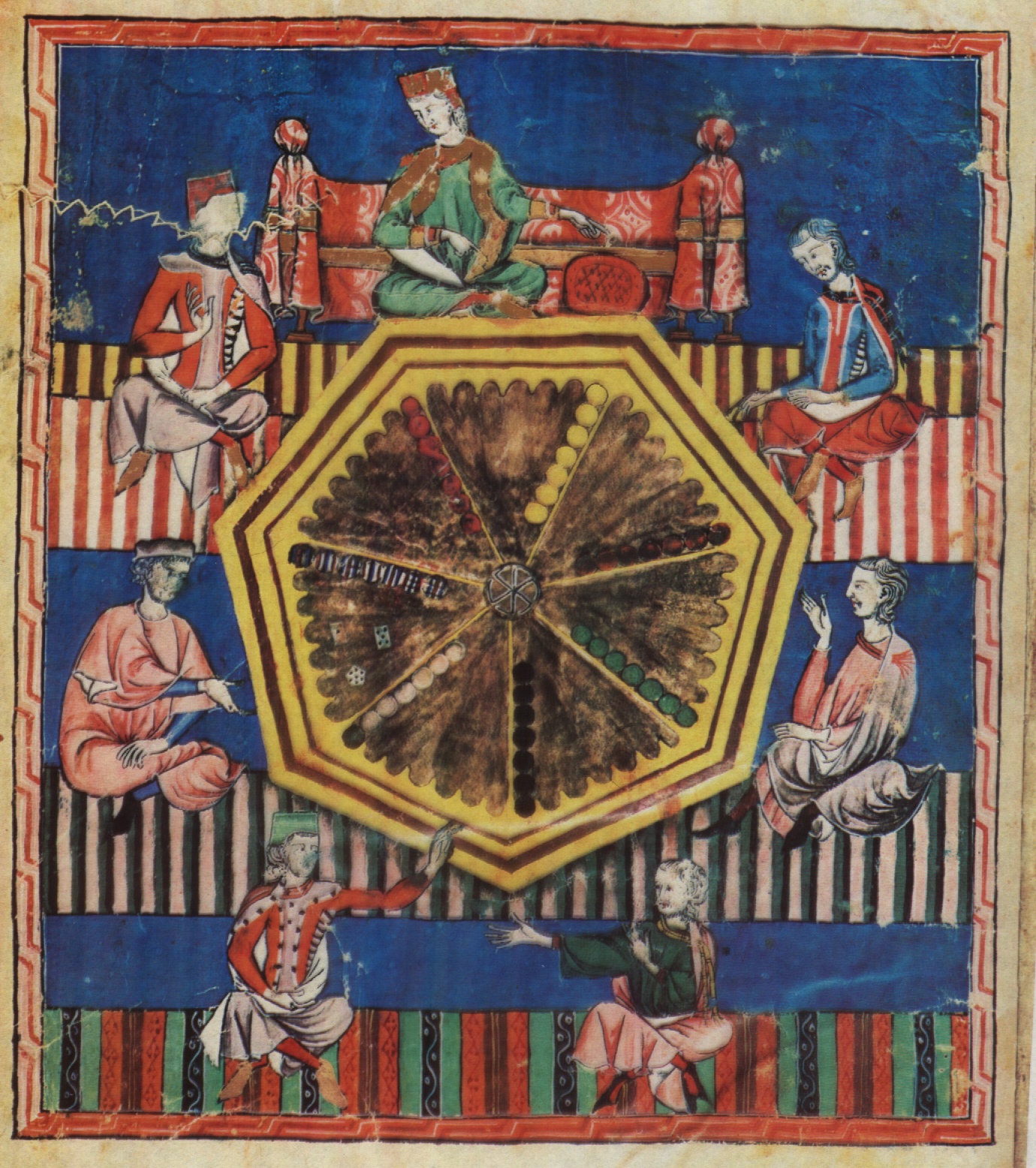When Abu Yusef Yaqub returned victorious to Fez In March, 1276 he began the building of El-Medinat el-Beida (White City), on the other side of the river from the old Idrisid city of Fez, which is now known as Fez el-Bali (Fez the Old). The new city was to be a showpiece of Islamic culture, like the Shining City of Córdoba had been two hundred years before. The madrasa of al-Karouine was becoming renowned as a centre of learning, and Abu wanted to elevate his caliphate to the same level of culture that the Umayyad caliphs had achieved. He didn’t know it then, but he was up against some stiff opposition from Toledo.
When King Alfonso’s father had driven the Almohads out of Iberia he discovered that they had left their libraries intact. During the rapid rise and spread of Islam, the different cultures they replaced were absorbed, not destroyed. Thousands of years of written history, science, religion astronomy and law were here in these parchment books and scrolls. But they were nearly all written in Arabic or Hebrew. From the beginning of his reign, King Alfonso instigated and personally supervised the translation of all the books in the libraries, employing Jewish, Christian and Muslim teams of translators. This group of scholars formed his royal scriptorium, known as the Escuela de Traductores de Toledo (Toledo School of Translators). By translating into Castilian, Alfonso promoted Castilian to a language of learning both in science and literature and established the foundations of the new Spanish language.
 Kalila wa-Dimna
Kalila wa-Dimna
One of the first books to be translated was a Castilian version of the animal fable Kalila wa-Dimna, a book of stories and sayings meant to instruct the monarch in proper and effective governance and was similar to Aesop’s fables. His next book, the Fuero Real was without doubt all Alfonso’s work and was a basis for the laws of his kingdoms and a textbook for the judiciary to follow in their day-to-day decisions.
In 1273 he created the Mesta, which was an association for sheep farmers. At first sight this seems to be a trivial innovation, but it came at a time when the traditional dominance of the English woollen trade had slumped. By coordinating the efforts of Castilian pastors, who until then were nomadic, Alfonso rejuvenated exports of Castilian wool to all Europe, and this vital clothing commodity became his kingdom’s biggest export, earning it the name of “white gold.”
With so many different languages, religions and legal systems deal with in his realm Alfonso tried to reform them under one legal code and one language.
 The Siete Partidas
The Siete Partidas
His father had attempted to do the same and had adopted the fueros of the Vizigoths, but they were only accepted in localised areas. Alfonso set up a commission of jurists (or members of the chancellery) to write the Siete Partidas a legal system in Castilian. More a universal encyclopedia for the governing of such different cultures, it incorporated philosophical and moral issues taken from Judean, Christian and Islamic teachings. On a more practical level, it guided the behaviour of his knights in carrying out their duties. The Siete partidas was never accepted by his nobles or his son who followed him as king, and it was only when his grandson, Alfonso XI, revived the laws nearly a hundred years later that they were widely adopted. One outcome that Alfonso could never have imagined was that his laws would be used to govern Spain’s post Columbus South American possessions, and are still a large part of their present day legislation. As a final recognition of Alfonso’s wisdom, his portrait hangs in the US House of Representatives chamber, along with 22 other lawmakers who are honoured there.
Perhaps his greatest contribution was to astronomy. Ptolomy’s Almagest, (The Greatest), which was written around 150 CE by the Greek astronomer, Claudius Ptolemy, but was taken from an earlier work from around 350 BCE by the Greek philosopher Aristotle, who was a profound thinker on just about every subject then known. Three hundred years after Ptolemy, the Persian astronomer Al-Sufi corrected many of Ptolemy’s original observations. To this was added the corrections of al-Andaluz astronomer al-Zarqali, and finally, what lay before King Alfonso’s translators was the sum total of all the world’s knowledge of astronomy in one place, and written in Castilian.
 The Alfonsine tables
The Alfonsine tables
That would be enough of an achievement for most scholars, but King Alfonso ordered his astronomers to create another set of tables from their own observations that accurately predicted the motion of the visible planets against the fixed stars. These he added to the Almagest as the Alfonsine tables. Just over two hundred years later, Nicolaus Copernicus had a copy of the Alfonsine tables with him when he was studying in Kraków, and the accurate measurements helped him form his own heliocentric theory, which places the sun in the centre of the solar system. Like Copernicus, Alfonso is honoured with the naming of a crater on the moon after him.
 Miniatures from The Cantigas de Santa Maria
Miniatures from The Cantigas de Santa Maria
Alfonso also dabbled in music and games. The Cantigas de Santa Maria, 420 poems with musical notation, written in medieval Galician, is often attributed to King Alfonso. It is one of the largest collections of monophonic (solo) songs from the Middle Ages, and is characterized by the mention of the Virgin Mary in every song, with every tenth song being a hymn. Only four manuscripts survive; two at El Escorial, one at Madrid's National Library, and one in Florence, Italy. The E codex from El Escorial is illuminated with coloured miniatures showing pairs of musicians playing a wide variety of instruments.
 Libro de axedrez, dados e tablas
Libro de axedrez, dados e tablas
King Alfonso’s Libro de axedrez, dados e tablas or Book of chess, dice and tables, consists of ninety-seven leaves of parchment, many with colour illustrations, and contains 150 miniatures. The text is a treatise that addresses the playing of three games: a game of skill, or chess; a game of chance, or dice; and a third game, backgammon.
Abu Yusef Yacub had none of Alfonso’s qualities or abilities, but he had ambition, an army, and he was ruthless. He had tested the strength of Castile and the Caliphate of Granada, and knew their weaknesses. Before leaving Iberia, Abu had signed a treaty with King Alfonso X, in which he promised not to attack Castile for two years. But he had left the broad Guadalquivir valley desolated. All the Christian settlers who had filled the void left by the Moors were now in the slave markets of Salé in Morocco, and their cattle distributed as booty to his al-qa’ids(military commanders). Abu knew how close he had come to defeating the Christians, and as soon as he returned to Africa, he began planning his second invasion, hoping that the Christians would not have time to repopulate the land that he had ravaged. Abu had only stopped because he had so decimated the land that he could not feed his army. In the next invasion, he would try to remedy that error.
In Castile, King Alfonso began to pick up the pieces of his kingdom. He had lost his eldest son, Ferdinand, but his younger brother, Sancho, had shown extraordinary courage and determination in leading his army in his absence; a character value that he was about to hugely underestimate. The death of Ferdinand had left two fatherless grandsons, Alfonso and Ferdinand de la Cerda, and King Alfonso unwisely decided to bypass his own two sons, Sancho and John, and nominate Alfonso as heir to the throne of Castile. At a stroke, he alienated his own sons, his wife and half of the nobles in his kingdom. Sancho claimed the right, of proximity of blood and agnatic seniority, which was laid down in the old Castilian laws, but Alfonso would not hear of it, and stubbornly refused to budge. His now estranged wife fled to Aragon, taking her grandsons with her for their own safety. Chroniclers have debated whether this family feud had disturbed the mind of King Alfonso at a critical time, because some of the decisions that he made over the next few years were nothing short of catastrophic for Castile.
Meanwhile, the treaty with Abu had expired, and in In August 1277, the emir crossed the straits again with a Moroccan army. As before, he swept north ravaging the lands south of the Guadalquivir. Abu’s son drove up the west coast and took the ports of Sanlúcar de Barrameda, Puerto Santa Maria and Rota, having first laid siege to Seville. He returned to Seville, but could not break the city, and after a month gave up. He had so devastated the land that his army was running out of food. He ordered his men to return to Algeciras with their slaves and booty and a month later, after re-provisioning, he swept north again to take Jerez before swinging east to join his father to take Córdoba. By the end of august, Emir Abu Yusef held the whole of west al-Andaluz in his fist. This was when he revealed his master plan. Instead of supporting Muhammad, the emir of Granada, he betrayed him, and formed an alliance with the Banu Ashqilula, his enemies.
Incandescent with rage, Muhammad is said to have paced the corridors of his palace alternately screaming abuse, or wailing his misfortune. Abu had been offered the port of Málaga as a bribe, a prize that he coveted. When he recovered, Muhammad asked for the support of Alfonso X and the Abdalwadid ruler Yaghmorassan of Tlemcen to punish the Marinids. It fell to Sancho again to lead Alfonso’s army against the Marinids.
In early 1279, while the Abdalwadids launched a diversionary raid on Morocco, and the Castilians dispatched a fleet to blockade the straits and stop Abu ferrying food and replacements for his army. Muhammad II led a Granadan army upon Málaga, which soon fell in a negotiated settlement. In a new treaty, Marinid emir Abu Yacub agreed to surrender his claims on Málaga and withdraw his protection of the Ashqilula, in return for which Muhammad II handed over Almunecar and Salobrena to the Marinids.
No sooner was this deal done, that the attention of the Muslim parties turned towards Marinid controlled Algeciras, which Alfonso X had decided to take for himself. Sancho had driven Abu south and laid siege to Algeciras. The ships of the order Santa Maria de España, specialists in naval warfare, dropped anchor off Isla Verde to stop Abu reliving it from the seaward side.
With another flip of loyalties, Muhammad II lent his own ships to join the Marinid fleet under the command of the Abu Yusuf's son, Abu Yaqub. The Moors were anxious not to let such an important port fall into Christian hands. The siege of Algeciras dragged on for months and took more out of the attackers than the defenders, who had bountiful supplies taken from the Guadalquivir valley. Alfonso’s navy soon ran out of supplies, and scurvy broke out among the crews, who abandoned their ships and came ashore. When Abu discovered that the fleet was abandoned, he sent his ships across the straits, captured the Christian navy, and lifted the siege at the Battle of Algeciras on 21 July 1279.
Sancho was still denied the crown of Castile by his father, and after displaying his courage in battle he had gained the loyalty of many of the nobles of Castile. Sancho was about to give his father a brutal lesson in kingliness.